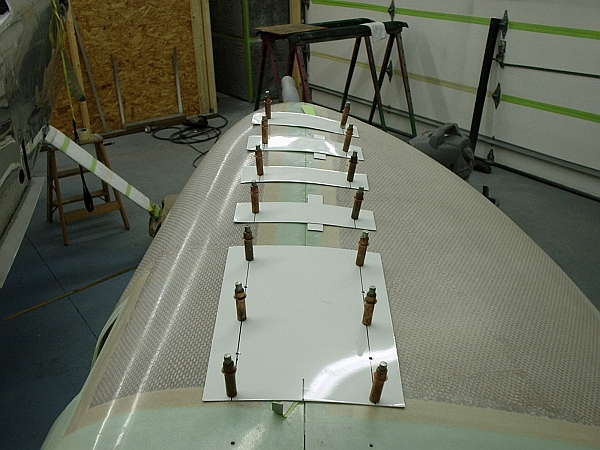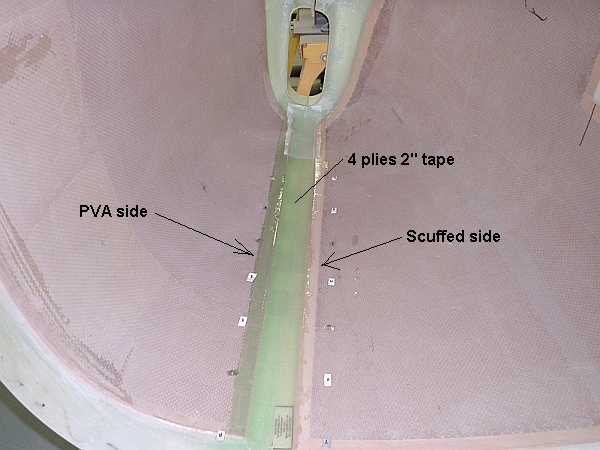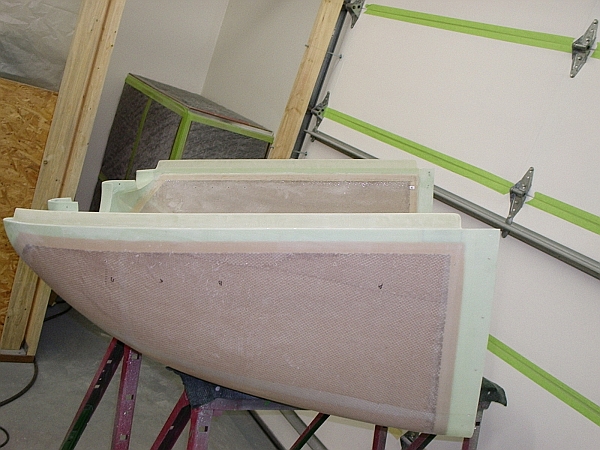Fitting a cowl, no hinges, so a flange is needed along the side for 1/4 turn fasteners or screws/nutplates. The usual method is a riveted and bonded aluminum strip. The problem is that such a strip is flat, while the cowl is rounded, in particular as you near the front. I suspect this to be the cause of some misalignment reports after fastener installation. So, an alternate method for your amusement. I elected to lay up some glass flanges; quite easy to do.
Get the cowl fittted and trimmed to your satisfaction. Sand (40 grit) the inner surface of the lower cowl for good bonding. Paint two coats of PVA on the upper cowl inner surface. Jig the cowl (by whatever means necessary) so the outer surfaces of the two parts are flush and the parts can't shift fore and aft in relation to each other. I used scrap aluminum and clecos plus some shims and tape here and there. The cleco holes are a non-issue; plenty of surface filling in the future anyway.

The flange layup is 5 plies of tape, pre-impregnated in plastic and dropped in place whole over a light epoxy "surface prime" wipe. Stipple or roll to eliminate air bubbles.

When cured, pop it apart and trim/sand the new flange 1" wide.

The finished product precisely matches the upper cowl curvature.
After installing all the fasteners, I'll probably go back in and add more flange all across the front around the cooling inlets, just to eliminate any visual gap between the cowl sections.
BTW, with an angle valve 360 or 390 there is not much clearance down the left side (1/2" or so max). I may ditch the planned Skybolts here and use screws/nutplates instead.
Get the cowl fittted and trimmed to your satisfaction. Sand (40 grit) the inner surface of the lower cowl for good bonding. Paint two coats of PVA on the upper cowl inner surface. Jig the cowl (by whatever means necessary) so the outer surfaces of the two parts are flush and the parts can't shift fore and aft in relation to each other. I used scrap aluminum and clecos plus some shims and tape here and there. The cleco holes are a non-issue; plenty of surface filling in the future anyway.

The flange layup is 5 plies of tape, pre-impregnated in plastic and dropped in place whole over a light epoxy "surface prime" wipe. Stipple or roll to eliminate air bubbles.

When cured, pop it apart and trim/sand the new flange 1" wide.

The finished product precisely matches the upper cowl curvature.
After installing all the fasteners, I'll probably go back in and add more flange all across the front around the cooling inlets, just to eliminate any visual gap between the cowl sections.
BTW, with an angle valve 360 or 390 there is not much clearance down the left side (1/2" or so max). I may ditch the planned Skybolts here and use screws/nutplates instead.
Last edited:






